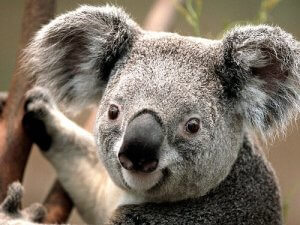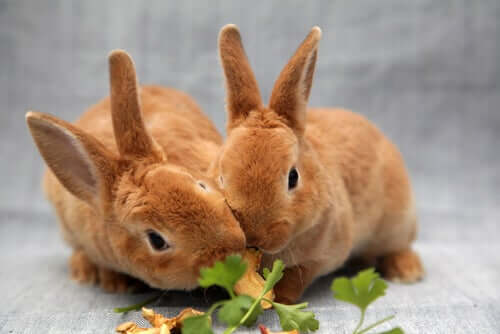The 7 Most Peaceful Animals on the Planet

When we talk about the ‘most peaceful animals on the planet,’ we mean those that, because of their personality, behavior, and nature, don’t attack other animals or people. In this article, we’ll talk about some of these amazingly gentle and calm wild animals.
Which are the most peaceful animals on the planet?
1. Manatee
This herbivorous marine mammal spends most of its time searching for food in shallow waters, either freshwater or saltwater. The manatee has a robust body and swims slowly. Its habitat lies near the coasts of America and Africa.
Its name derives from an indigenous Caribbean language, which means ‘with breasts’. It can measure up to 13 ft long and weigh 1,300 lbs. Its body is pinkish grey and its tail is flattened into a spatula shape. Their only known predator is man as they are hunted for their fat and meat.

2. Rabbit
Have you ever wondered why magicians use rabbits for their tricks? It’s because when they cover them with a cloth, instead of trying to escape, they stay calm and quiet. These species are indeed one of the most peaceful animals in the world. Having said that, there are some cases of aggression in rabbits.
This mammal is characterized by its large pointed ears which allow it to regulate their body temperature. They possess a short and rounded tail, and very receptive nose and whiskers. On the other hand, its teeth grow continuously and it needs to wear them out by eating branches, vegetables or seeds. Moreover, they can reproduce at a very fast pace.
3. Sloth
Endemic to the rainforests of Central and South America, sloths are quiet and slow-moving mammals. They’re genetically related to the anteater and their main predators are man, anacondas, pumas, and jaguars.
As for their diet, as they have slow-digesting stomachs, they spend their lives in trees eating leaves and tender shoots. However, in some cases, sloths can consume some small insects. In addition, their front legs are longer than their hind legs, and they have hooked nails to hang from tree branches. In extreme cases, they’ll use their limbs to defend themselves from attacks.
4. Koala bear
This marsupial lives in coastal areas of Oceania, especially in Australia. Morphologically, it has a robust body, a large head, and round, hairy ears. It also has no tail and its fur is grey or brown-colored. In addition, its nose is notable for its size compared to its face and is usually black in color.
Regarding its habits, it feeds on eucalyptus leaves, lives a sedentary life and can sleep up to 20 hours a day. They only quarrel with each other during the mating season, other than that they’re rather peaceful and calm animals.
5. Panda Bear
Although large in size, this bear species is the most peaceful of its family. They inhabit the mountainous regions of China. Moreover, their main source of food is bamboo, and it has a black and white coat, which is world-famous.
It is a rather solitary animal though, usually more active at dawn and dusk. In addition, it possesses a sixth toe on its paws that allows it to be a good climber. Its reproduction cycle is slow and the mating season takes place in spring. Nevertheless, the International Union for Conservation of Nature announced that pandas have been upgraded from “endangered” to “vulnerable.”

6. Siamese cat
Cat experts consider this breed to be the most peaceful of its kind. There are two varieties – modern and traditional Siamese – and although it can show its discontent when something doesn’t please it, it is usually quite a calm cat.
They’re even more affectionate than any other cat and usually wait for their owner at the door. In addition, they can be very prolific, and during the rutting season they can meow all night long. This can be solved by neutering.
7. North Atlantic right whale
This giant mammal lives in the North Atlantic Ocean and, because of its docile personality along with its slow movements, it is one of the most endangered and threatened whales. Moreover, poachers take advantage of this to capture them when they approach their boats or the coastline.
Its coloration is dark grey to black, white some individuals having white spots on their stomachs or throats. This marine giant can measure between 43–52 ft in length and weigh between 44 and 77 tons. In addition, they feed on krill and larvae, are fertile from the age of 10 and can give birth to one calf per litter every 3 to 6 years.
When we talk about the ‘most peaceful animals on the planet,’ we mean those that, because of their personality, behavior, and nature, don’t attack other animals or people. In this article, we’ll talk about some of these amazingly gentle and calm wild animals.
Which are the most peaceful animals on the planet?
1. Manatee
This herbivorous marine mammal spends most of its time searching for food in shallow waters, either freshwater or saltwater. The manatee has a robust body and swims slowly. Its habitat lies near the coasts of America and Africa.
Its name derives from an indigenous Caribbean language, which means ‘with breasts’. It can measure up to 13 ft long and weigh 1,300 lbs. Its body is pinkish grey and its tail is flattened into a spatula shape. Their only known predator is man as they are hunted for their fat and meat.

2. Rabbit
Have you ever wondered why magicians use rabbits for their tricks? It’s because when they cover them with a cloth, instead of trying to escape, they stay calm and quiet. These species are indeed one of the most peaceful animals in the world. Having said that, there are some cases of aggression in rabbits.
This mammal is characterized by its large pointed ears which allow it to regulate their body temperature. They possess a short and rounded tail, and very receptive nose and whiskers. On the other hand, its teeth grow continuously and it needs to wear them out by eating branches, vegetables or seeds. Moreover, they can reproduce at a very fast pace.
3. Sloth
Endemic to the rainforests of Central and South America, sloths are quiet and slow-moving mammals. They’re genetically related to the anteater and their main predators are man, anacondas, pumas, and jaguars.
As for their diet, as they have slow-digesting stomachs, they spend their lives in trees eating leaves and tender shoots. However, in some cases, sloths can consume some small insects. In addition, their front legs are longer than their hind legs, and they have hooked nails to hang from tree branches. In extreme cases, they’ll use their limbs to defend themselves from attacks.
4. Koala bear
This marsupial lives in coastal areas of Oceania, especially in Australia. Morphologically, it has a robust body, a large head, and round, hairy ears. It also has no tail and its fur is grey or brown-colored. In addition, its nose is notable for its size compared to its face and is usually black in color.
Regarding its habits, it feeds on eucalyptus leaves, lives a sedentary life and can sleep up to 20 hours a day. They only quarrel with each other during the mating season, other than that they’re rather peaceful and calm animals.
5. Panda Bear
Although large in size, this bear species is the most peaceful of its family. They inhabit the mountainous regions of China. Moreover, their main source of food is bamboo, and it has a black and white coat, which is world-famous.
It is a rather solitary animal though, usually more active at dawn and dusk. In addition, it possesses a sixth toe on its paws that allows it to be a good climber. Its reproduction cycle is slow and the mating season takes place in spring. Nevertheless, the International Union for Conservation of Nature announced that pandas have been upgraded from “endangered” to “vulnerable.”

6. Siamese cat
Cat experts consider this breed to be the most peaceful of its kind. There are two varieties – modern and traditional Siamese – and although it can show its discontent when something doesn’t please it, it is usually quite a calm cat.
They’re even more affectionate than any other cat and usually wait for their owner at the door. In addition, they can be very prolific, and during the rutting season they can meow all night long. This can be solved by neutering.
7. North Atlantic right whale
This giant mammal lives in the North Atlantic Ocean and, because of its docile personality along with its slow movements, it is one of the most endangered and threatened whales. Moreover, poachers take advantage of this to capture them when they approach their boats or the coastline.
Its coloration is dark grey to black, white some individuals having white spots on their stomachs or throats. This marine giant can measure between 43–52 ft in length and weigh between 44 and 77 tons. In addition, they feed on krill and larvae, are fertile from the age of 10 and can give birth to one calf per litter every 3 to 6 years.
All cited sources were thoroughly reviewed by our team to ensure their quality, reliability, currency, and validity. The bibliography of this article was considered reliable and of academic or scientific accuracy.
- Arteaga M., & Jorgenson J. (2007). Hábitos de desplazamiento y dieta del capibara (Hydrochoerus hydrochaeris) en la Amazonia colombiana. Mastozoología neotropical, 14(1), 11-17. Recuperado de: https://www.redalyc.org/pdf/457/45714102.pdf
- Carder, G., Plese, T., Machado, F. C., Paterson, S., Matthews, N., McAnea, L., & D’Cruze, N. (2018). The impact of ‘selfie’tourism on the behaviour and welfare of brown-throated three-toed sloths. Animals, 8(11), 216. Recuperado de: https://www.mdpi.com/2076-2615/8/11/216
- Feng C. (2005). Florida Manatees: On the Brink of Extinction. Journal of Young Investigatiors. Recuperado el 12 de febrero 2023 en: https://www.jyi.org/2005-september/2005/9/7/florida-manatees-on-the-brink-of-extinction
- Smith J. (2003). Beyond dominance and affection: Living with rabbits in post-humanist households. Society & Animals, 11(2), 181-197. Recuperado de: https://brill.com/view/journals/soan/11/2/article-p181_4.xml
- Gilmore D., Da Costa C., & Duarte D. (2001). Sloth biology: an update on their physiological ecology, behavior and role as vectors of arthropods and arboviruses. Brazilian Journal of Medical and Biological Research, 34, 9-25. Recuperado de: http://www.scielo.org.ar/pdf/bjmbr/v34n1/3877.pdf
- Hart B., & Hart L. (2013). Your ideal cat: insights into breed and gender differences in cat behavior. Purdue University Press. Recuperado de: https://books.google.com.mx/books?hl=es&lr=&id=
- Ministerio para la Transición Ecológica (2018). Ballena vasca o franca glacial. Eubalaena glacialis. Recuperado el 22 de mayo 2022 en: https://www.miteco.gob.es/es/biodiversidad/temas/recursos-geneticos/eubalaenaglacialisballenavasca_tcm30-478455.pdf
- Smith M. (1979). Behaviour of the Koala, Phascolarctos Cinereus Goldfuss, in Captivity. 1. Non-Social Behaviour. Wildlife Research, 6(2), 117-129. Recuperado de: https://www.publish.csiro.au/wr/WR9790117
- Wenshi P. (2014). A chance for lasting survival: Ecology and behavior of wild giant pandas. Smithsonian Institution. Recuperado de: https://books.google.com.mx/books?hl=es&lr
This text is provided for informational purposes only and does not replace consultation with a professional. If in doubt, consult your specialist.








